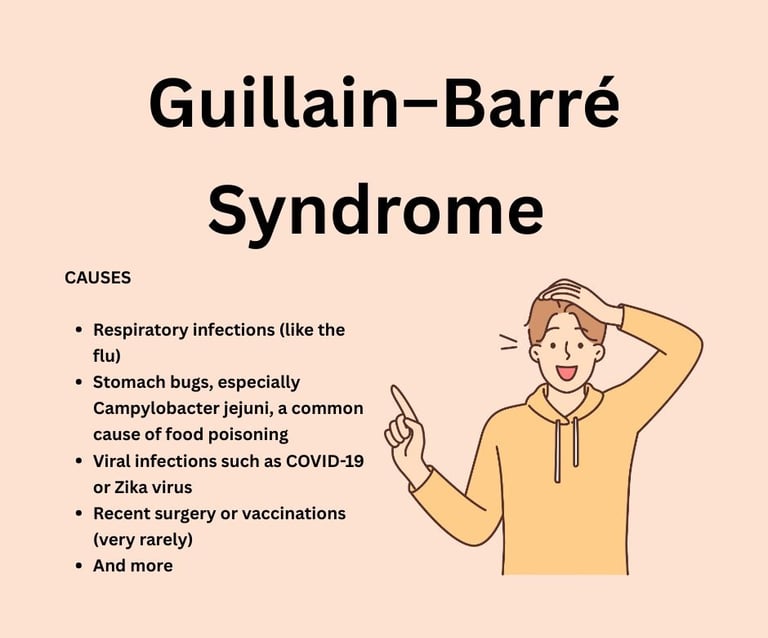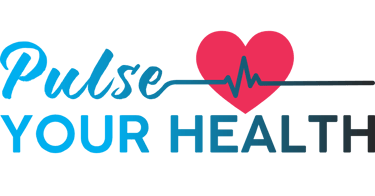Stay updated on what is trending in health. Discover tips and resources for a healthier, balanced life.
Guillain–Barré Syndrome: What You Need to Know About This Rare Nerve Disorder
Learn about Guillain–Barré Syndrome (GBS), a rare nerve disorder that can cause muscle weakness and paralysis. Discover its causes, symptoms, treatment options, and recovery tips
DISEASES AND CONDITIONS
Dr. S. Ali
6/1/20253 min read


Have you ever heard of a condition where your body’s own immune system mistakenly attacks your nerves? It sounds alarming—and it is. This condition is called Guillain–Barré Syndrome, or GBS for short. Although it’s rare, it can be serious and even life-threatening if not treated promptly. But don’t worry—knowledge is power. In this article, we’ll walk you through what GBS is, its symptoms, causes, treatments, and what recovery might look like.
So, What Is Guillain–Barré Syndrome?
Guillain–Barré Syndrome is a rare neurological disorder in which the body’s immune system mistakenly targets the peripheral nerves—the ones outside your brain and spinal cord. Think of it like friendly fire: your own defenses attacking your nerve insulation, causing communication between your brain and muscles to get scrambled.
Most people with GBS experience sudden muscle weakness and sometimes even paralysis. The good news? With proper treatment and support, many people recover, although it can take time.
What Causes Guillain–Barré Syndrome?
Guillain–Barré Syndrome occurs when the body’s immune system mistakenly attacks the peripheral nerves. While the exact reason why this happens isn’t fully understood, researchers believe it’s often triggered by an immune response to a recent infection or, less commonly, other medical events.
Common known triggers include:
Respiratory infections (like the flu)
Stomach bugs, especially Campylobacter jejuni, a common cause of food poisoning
Viral infections such as COVID-19 or Zika virus
Recent surgery or vaccinations (very rarely)
Other infections and immune triggers may also contribute. While these factors can precede GBS, the overall risk is low—most exposed individuals never develop it, suggesting genetic or immune susceptibility plays a role in rare cases.
Typically, GBS arises days to weeks after an infection. Researchers believe that, in some people, the immune system mistakenly attacks nerves—a phenomenon called molecular mimicry—confusing them with parts of the prior infection. This misguided attack causes inflammation and damage to the peripheral nervous system.
Common Signs and Symptoms
Symptoms usually start in the legs and spread upward. They may come on suddenly and worsen quickly over hours or days.
Here’s what to watch out for:
Tingling or “pins and needles” in your feet or hands
Muscle weakness, starting in the legs and spreading to the upper body
Difficulty walking or climbing stairs
Unsteady gait or trouble with balance
Severe pain, especially at night
Difficulty with eye or facial movements (like speaking, chewing, or swallowing)
Problems with bladder control or digestion
In severe cases: breathing difficulties or paralysis
Professional tip: If you or someone you know experiences sudden muscle weakness or numbness—especially after a recent infection—don’t wait. Seek medical help immediately.
Who’s at Risk?
Guillain–Barré Syndrome can affect people of all ages, but it’s more common in adults, especially those over the age of 50. That said, children can also develop GBS, though it’s relatively rare.
In children, GBS often follows a viral or gastrointestinal illness. Symptoms may be harder to spot early on—especially if the child can't describe sensations like tingling or weakness—but early medical attention is still crucial.
The good news? Children tend to recover more fully and quickly than adults, especially with prompt diagnosis and care.
How Is GBS Diagnosed?
Diagnosing Guillain–Barré isn’t always straightforward, but doctors typically use a combination of:
Neurological exam: To assess muscle strength and reflexes
Lumbar puncture (spinal tap): To check the fluid around your brain and spinal cord
Electromyography (EMG): To evaluate nerve and muscle activity
Blood tests: To rule out other conditions
Treatment Options
While there’s no specific cure that instantly reverses Guillain–Barré Syndrome, several effective treatments can reduce the severity, shorten the duration, and support recovery:
Plasma exchange (plasmapheresis): Removes harmful antibodies from your blood
IV immunoglobulin (IVIG): A treatment made from donated blood that can block the damaging antibodies
Supportive care: Including pain relief, breathing support (if needed), and physical therapy
Early treatment makes a huge difference, so quick diagnosis is key.
What’s the Outlook?
Most people start recovering within a few weeks of treatment, though full recovery can take months—or even years—for some. Around 70% of people recover completely, but others may experience lingering weakness or nerve damage.
Good news: GBS is rare, and most people bounce back with proper care.
Living with and Beyond GBS
Recovering from GBS can be physically and emotionally challenging. Rehabilitation often includes:
Physical therapy: To regain strength and mobility
Occupational therapy: To adapt daily tasks
Mental health support: Coping with anxiety, depression, or PTSD post-recovery
Final Thoughts
Guillain–Barré Syndrome is rare, but it’s something everyone should be aware of—especially after an infection. The key takeaway? Pay attention to your body. If weakness, tingling, or coordination problems appear out of nowhere, it’s always better to get checked out.
Sources:
1. National Institute of Neurological Disorders and Stroke (NINDS)
https://www.ninds.nih.gov/health-information/disorders/guillain-barre-syndrome
2. World Health Organization (WHO) Fact Sheet
https://www.who.int/news-room/fact-sheets/detail/guillain-barre-syndrome
3. CDC Vaccine Safety Information
https://www.cdc.gov/vaccine-safety/about/guillain-barre.html
4. Mayo Clinic Patient Information
https://www.mayoclinic.org/diseases-conditions/guillain-barre-syndrome/symptoms-causes/syc-20362793
5. GBS/CIDP Foundation International
https://www.gbs-cidp.org/gbs/
6. NIH StatPearls Clinical Guide
https://www.ncbi.nlm.nih.gov/books/NBK532254/
Pulse Your Health
Empowering you to achieve your health goals.
Contact
© 2025. All rights reserved.
Disclaimer: The content on this website is for informational purposes only and is not medical advice. Always seek the advice of your physician or other suitably qualified healthcare professional for diagnosis, treatment and your health related needs.
